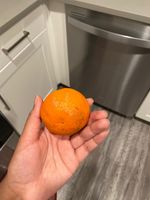A classic question about the freshness and quality of an orange often arises among home chefs and fruit aficionados alike. The answer isn't always black and white, but the understanding of three primary indicators – color, smell, and touch – can save the day. Whether you're dealing with a supermarket bin or a basket from your local farmers market, here's a simple guide to helping you spot a bad orange when you're just about to cut into it.
Look
The first step in assessing the freshness of an orange is to take a close look at its skin. A fresh orange is typically a bright shade of orange, with a uniform color and minimal discoloration. If you notice any brown or yellowing spots, or if the skin feels dull, soft, or dry, these are clear signs that the orange has seen better days. Even a small scar on the peel from minor injuries is usually insignificant; just make sure it doesn't compromise the integrity of the orange itself.
Smell
Next, give the orange a good sniff to discern its scent. A fresh, ripe orange has a vibrant, citrusy aroma that's inviting and sweet. Anything that smells sour, moldy, or offensively should be considered a sign that the orange has started to spoil. If your nose wrinkles at the scent or if you notice the distinct aroma of mold, it's time to pitch it out.
Touch
Lastly, gently press on the orange with your finger or thumb. A fresh, ripe orange should have a somewhat firm texture – not too hard or too soft. If the skin feels spongey, soft, or squishy, the fruit has probably gone beyond its prime and is best avoided. Conversely, a firm, crisp orange that resists pressure is likely to be fresh and edible.
It's worth noting that no single test will tell you with 100% certainty if an orange is bad. A combination of these methods – along with a bit of intuition – will help you make the best decision. Sometimes, it's more about being cautious than being right.
In summary, when it comes to determining the quality of an orange, color, smell, and touch are the key indicators to consider. By carefully evaluating these factors, you're sure to make an informed choice about the integrity of your fruit. Remember, the best oranges are often those that adhere strictly to these guidelines, but there's always room for a little experimentation to refine your skills.
So, the next time you're faced with a bounty of oranges, don't be afraid to employ these simple yet effective methods to separate the ripe ones from the moldy ones. Happy tasting!
This answer provides a detailed and informative guide on how to identify whether an orange is bad, based on its appearance, smell, and touch. It emphasizes the importance of using all three methods for a comprehensive assessment, with some additional insights and explanations to help readers better understand the factors involved.









